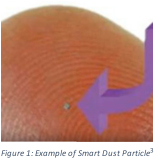Smart Dust – The Future of Global IoT
Twitter: @SecurityMonahan
With Internet of Things (IoT) devices playing a greater role business, there are many ongoing conversations to discuss the advancement of IoT devices and their impact on IT operations and security (and there will be more conversations in the future). However, no IoT device is so wildly fantastic (or outrageous) as “smart dust,” which is proof that IoT miniaturization seems to be working its way into the realm of nanotechnology.
It is incredible to think about all the ways IoT began working its way into the business IT environment. We already have a plethora of Internet-connected sensors, control mechanism appliances and home automation gizmos. These are increasing in number on a daily basis. However, understanding where scientists are taking this technology concept is even more mindboggling.
Smart Dust consists of sensors at the nanotechnology level that can be deployed in the millions to billions, with a myriad of applications. Smart Dust is both the ultimate instantiation and the ultimate nightmare for IoT. On an individual level, the Smart Dust devices are referred to as MOTES or MEMS. “MOTES” refers to a generic tiny particle,1 while “MEMS” is a more specialized term that stands for “micro-electromechanical sensors.”2 These devices are the wave of the future for anything from global weather management and smart city monitoring to war theater mapping and internal medicine. They are a single package with sensing, computation, communication, an d power to collect data and report it back to home base.
d power to collect data and report it back to home base.
They could easily be misused for surveillance and environmental data collection, possibly manipulation, in any location. Being as small as they are, if dropped near a target facility, the personnel entering would be covered in them and even inhale them, making a secure facility obsolete. Since they can be inhaled, even standard procedures such as clothing changes, dust suits, and broad spectrum communications jamming would be ineffectual because once the person leaves the environment with the sensors inside of them, they can report back on what they discovered.
Since it is highly unlikely that smart dust will be leveraged for corporate espionage in the near future, organizations do not have to jump into high gear or stay awake at night to devise a defense plan. Without going totally Sci-Fi and high-cost, with body scanners and irradiation to short out the sensors, the best defense we can currently leverage is visibility. Seeing any unauthorized device in the environment is a core part of any security strategy. Regardless of size, to be an effective espionage or reconnaissance tool, the device has to communicate what it learns. That is how they get caught. When the unknown device attempts to either interact with existing systems to gather data or contact its control base to disseminate it, security should be on top of that to stop it before the information is collected or before it can be transmitted. If that happens, security wins.
Create a means for visibility in your environment to protect against infiltration, lateral movement, data collection, and ultimately, dissemination.
1 http://www.dictionary.com/browse/mote
2 https://en.wikipedia.org/wiki/Microelectromechanical_systems
3 Picture Reference: http://www.federaljack.com/smart-dust-aims-to-monitor-everything-2/